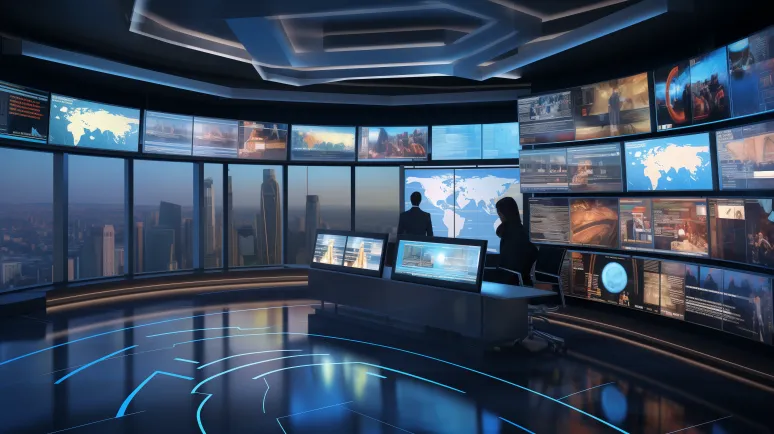Table of Contents
In the future, AI might replace TV news anchors. The AI TV News Network could change how news is presented. Jobs like newscasting might be done by artificial intelligence. This means machines might take over this job too. It’s part of a trend where AI takes over jobs people used to do.
Revolutionizing Broadcasting: AI TV News Network by Channel 1
In the coming months, a new California startup, Channel 1, is getting ready to unveil something groundbreaking. They’re about to launch the world’s first AI TV News Network. Instead of real people, you’ll hear news stories narrated by digital avatars that look and sound remarkably lifelike.
This innovative approach uses artificial intelligence to bring you the latest updates uniquely and engagingly. Channel 1 is spearheading this exciting venture, introducing a fresh perspective to news reporting through the use of cutting-edge technology. Get ready for a whole new experience with the AI TV News Network!
In creating the AI TV News Network, Channel 1’s founder, Adam Mosam, views AI-powered reporters as more of an embellishment. His main goal is to utilize AI for tailoring TV newscasts to individual viewers. These broadcasts will include reports from worldwide sources, presented in the viewer’s preferred language.
However, some are concerned about the impact on jobs, with labor leaders and experienced broadcasters questioning whether Channel 1 signals the initial phase of replacing numerous well-paid on-air positions with AI technology.
Retired Boston sportscaster Bob Lobel, known for his time on WBZ-TV, finds the AI TV News Network both scary and interesting. He thinks about all the money saved by not having real people at the anchor desk, which could be hundreds of thousands of dollars.
SAG-AFTRA’s Stand Against AI-Generated News Anchors

SAG-AFTRA, the actors’ union, recently had a successful strike to set rules for using AI-generated actors in movies. This union also looks after 5,000 TV news workers. Duncan Crabtree-Ireland, SAG-AFTRA’s national executive director, thinks using AI for news anchors would be a big error. They want to ensure that real people stay as the main faces of the AI TV News Network.
“People watch familiar news anchors for years because they trust and relate to them. They see them as real people and believe in what they report,” Crabtree-Ireland explained, highlighting the importance of human connection in news. This is relevant for the credibility and engagement of an AI TV News Network.
At AI TV News Network, the people you see aren’t real, but they’re not completely fake either. They use real actors whose looks and voices are captured digitally. When they read a story script, their avatars speak in their voice, and thanks to AI, their lips move just like real people. Even gestures and head movements look natural, making news easy to follow, no matter the language.
Mosam emphasized that his intention is not to replace human broadcasters with automation. He clarified that the primary objective of their project is to focus on the customization and personalization of news content.
Channel1’s Tailored News Experience
AI TV News Network, Channel 1, plans to start on a phone app and wants to become a channel on Pluto and Crackle. They’ll use a special system, like social media, to make news shows just for you. For example, if you’re in America but like news from France, you’ll see reports from Paris in English. The system learns what you like and makes a news show with local and global stories, just for you.
In creating the AI TV News Network, Mosam emphasized that even though AI generates avatar dialogues, human editors review and approve scripts. At each newsroom stage, human oversight is present. Channel 1 may hire correspondents for field coverage when needed. Unlike OpenAI and Microsoft facing legal issues, Channel 1 aims to license video content from global traditional news sources for its AI TV news system.
Paul Niwa, the assistant dean of Emerson College’s School of Communication, expressed skepticism about the future of Channel 1. According to Niwa, the viewership for traditional TV news, regardless of whether it is presented by human or digital news anchors, is declining as the baby boom generation ages.
Niwa, a former producer at NBC News, described it as attempting to imitate a type of news that is currently in its elderly stage. He believes that it is something that will eventually vanish.
According to a recent Pew Research study, the number of US residents who regularly watch TV news has dropped to 32 percent, down from 40 percent in 2020. On the other hand, 56 percent of people now depend on digital devices such as smartphones to get their news.
Niwa argued that it is not logical for an AI-powered news platform to merely imitate the format of television news that was first introduced in the 1950s. Instead of replicating an existing style, he emphasized the importance of exploring innovative approaches and seizing new possibilities.
Mosam believes that Channel 1 will emerge victorious, not due to its attractive avatars, but because it offers immediate access to video news in various languages from almost any location. Mosam stated, “If we excel at keeping people informed, we will thrive.”